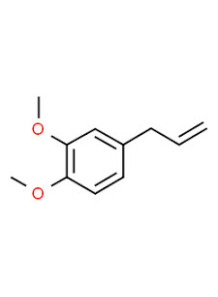Methyl Eugenol (98%)
- Product Code: 36015
natural organic compound commonly found in essential oils of various plants such as basil, bay, and clove. It has been studied for its potential as an insect attractant and as a component in insect repellants
- -
- -
- -
- -
- -
- -
- -
- -
- -
- -
- -
- -
- -
- -
- -
- -
- -
Methyl eugenol is a natural organic compound commonly found in essential oils of various plants such as basil, bay, and clove. It has been studied for its potential as an insect attractant and as a component in insect repellants. Here's an overview of its properties and uses:
Properties of Methyl Eugenol:
- Chemical Structure: Methyl eugenol is a phenylpropanoid compound with a structure similar to eugenol, but with a methoxy group (-OCH3) instead of a hydroxyl group (-OH).
- Source: It is present in essential oils from plants like basil (Ocimum basilicum), bay (Pimenta racemosa), and clove (Syzygium aromaticum).
Uses in Insect Control:
- Attractant: Methyl eugenol is highly attractive to certain species of insects, particularly fruit flies (Tephritidae family). It is often used in traps to lure and capture these pests, aiding in pest management and monitoring.
- Repellant: While its primary use is as an attractant, methyl eugenol can be formulated with other compounds to create insect repellants. However, its effectiveness as a standalone repellant is limited compared to its attractant properties.
Mechanism of Action:
- Attractant: Methyl eugenol mimics the scent of natural food sources or mating cues for certain insects, drawing them towards traps where they can be captured or killed.
- Repellant: When used in repellant formulations, methyl eugenol's scent can deter some insects from approaching treated areas, although its primary function remains as an attractant.
Applications in Agriculture:
- Pest Monitoring and Control: Methyl eugenol traps are used to monitor and control populations of fruit flies in orchards and agricultural fields. These traps help reduce crop damage by capturing adult flies before they can lay eggs.
- Integrated Pest Management (IPM): In IPM programs, methyl eugenol is combined with other pest control methods to manage insect populations effectively and sustainably.
Be the first to review this product :-)
Recommend Lab-Service
| Lab Service | Price |
|---|

natural organic compound commonly found in essential oils of various plants such as basil, bay, and clove. It has been studied for its potential as an insect attractant and as a component in insect repellants
Methyl eugenol is a natural organic compound commonly found in essential oils of various plants such as basil, bay, and clove. It has been studied for its potential as an insect attractant and as a component in insect repellants. Here's an overview of its properties and uses:
Properties of Methyl Eugenol:
- Chemical Structure: Methyl eugenol is a phenylpropanoid compound with a structure similar to eugenol, but with a methoxy group (-OCH3) instead of a hydroxyl group (-OH).
- Source: It is present in essential oils from plants like basil (Ocimum basilicum), bay (Pimenta racemosa), and clove (Syzygium aromaticum).
Uses in Insect Control:
- Attractant: Methyl eugenol is highly attractive to certain species of insects, particularly fruit flies (Tephritidae family). It is often used in traps to lure and capture these pests, aiding in pest management and monitoring.
- Repellant: While its primary use is as an attractant, methyl eugenol can be formulated with other compounds to create insect repellants. However, its effectiveness as a standalone repellant is limited compared to its attractant properties.
Mechanism of Action:
- Attractant: Methyl eugenol mimics the scent of natural food sources or mating cues for certain insects, drawing them towards traps where they can be captured or killed.
- Repellant: When used in repellant formulations, methyl eugenol's scent can deter some insects from approaching treated areas, although its primary function remains as an attractant.
Applications in Agriculture:
- Pest Monitoring and Control: Methyl eugenol traps are used to monitor and control populations of fruit flies in orchards and agricultural fields. These traps help reduce crop damage by capturing adult flies before they can lay eggs.
- Integrated Pest Management (IPM): In IPM programs, methyl eugenol is combined with other pest control methods to manage insect populations effectively and sustainably.
| Mechanism | - |
| Appearance | - |
| Longevity | - |
| Strength | - |
| Storage | - |
| Shelf Life | - |
| Allergen(s) | - |
| Dosage (Range) | - |
| Recommended Dosage | - |
| Dosage (Per Day) | - |
| Recommended Dosage (Per Day) | - |
| Mix Method | - |
| Heat Resistance | - |
| Stable in pH range | - |
| Solubility | - |
| Product Types | - |
| INCI | - |
Cart
No products



